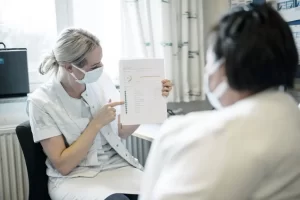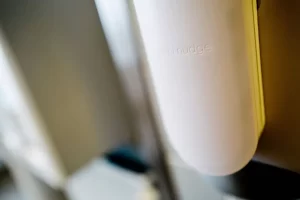Stating the obvious
Do we at all need a business case in order to convince hospitals that hand hygiene is efficient and important to protect patients? When alcohol-based hand gel was first introduced to hospitals, was it then required to provide a business case? No. Simply because we know that proper hand hygiene is the easiest way to protect yourself and patients from hospital-acquired infections – and it has been known for many years.
A trip down memory lane
In 1846, the Hungarian Doctor Semmelweis noticed that the women giving birth in the medical maternity ward run by doctors and medical students were more likely to develop a fever and die compared to the women giving birth in the adjacent midwife-run maternity ward. He also noted that doctors and medical students often went directly to the delivery suite after performing autopsies and had a disagreeable odor on their hands despite handwashing with soap and water before entering the clinic. Based on this observation, he hypothesized that those performing autopsies got ‘particles’ on their hands, which they then carried from the autopsy room into the maternity ward.
As a consequence, Semmelweis recommended that hands should be scrubbed in a chlorinated lime solution before every patient contact and particularly after leaving the autopsy room. Following the implementation of this measure, the mortality rate fell dramatically to 3% in the clinic most affected and remained low thereafter.
This is the first evidence that cleansing heavily contaminated hands with an antiseptic agent can reduce nosocomial transmission of germs more effectively than handwashing with plain soap and water.
A few years later, the Crimean War brought about a new handwashing champion, Florence Nightingale, the English founder of modern nursing. At a time when most people believed that infections were caused by foul odors called miasmas, Florence Nightingale implemented handwashing and other hygiene practices. Nightingale’s handwashing practices achieved reductions in infections.
Status of today
Many other investigations conducted over the past 40 years have confirmed the important role that contaminated HCWs’ hands play in the transmission of hospital-associated pathogens.
More recently, the HICPAC guidelines (federal advisory committee appointed to provide advice and guidance to DHHS and CDC) defined alcohol-based hand rubbing as the standard of care for hand hygiene practices in health-care settings, whereas handwashing is reserved for particular situations only.
In recent years, alcohol-based hand rubbing has been gaining recognition as a cost-effective, essential tool for achieving good health. Now that its effectiveness is no longer in question, the main focus is on how to make staff, patients and visitors perform hand hygiene.
Many hospitals spend time, energy and resources in stating the obvious. What is most concerning, is that bureaucratic processes delays and sometimes prevent hygiene organizations to perform hygiene improvement work. This lack of agility and inability has consequences. Globally, at least 5 patients die every minute because of unsafe care, and hospital-acquired infections is a dominant contributor.
The business case of hand hygiene
We know that hospital-acquired infections are costly. A well-conducted Swedish study found that the average additional costs of the four most common types of hospital-acquired infections in medical and surgical wards are approx. 12.000 EUR per patient. It is also well-documented that of every 100 hospitalized patients at any given time, 7 in developed and 10 in developing countries will acquire at least one hospital-acquired infection. In ICUs, approximately 30% of patients are affected by at least one hospital-acquired infection. The number of hospital-acquired infections can be reduced by at least 20% with improved hand hygiene. I will let you do the math.
No one is questioning the business case of alcohol-based hand gel and hand sanitation – and no one should. Hand sanitation is part of our infection prevention guidelines because it works. However, the true problem is that staff only remember to sanitize in 40% of the situations when it is required according to the guidelines. This has been documented both with video cameras and with automated monitoring systems. Unfortunately, many hospitals still believe that the staff have good compliance because they are using direct (manual) observations.
Direct observations have shown to overestimate compliance significantly with 55%. Imagine you think that the hand hygiene compliance is 85% because you are using direct observations but in reality, your organizations compliance is only 38.25%! This is the reality for many hospitals today.
As an MD, PhD being scientifically driven and believing in the power of data, I can of course not support an approach such as direct observations. In addition to the overestimation, the method only captures less than 0.01% of all hand hygiene opportunities – and with no knowledge on compliance in toilets and other critical areas. This is a huge limitation from a scientific and quality point of view. In the near future, direct observations will hopefully not be a way of providing an estimate of hand hygiene compliance in developed countries.
So, where does it leave us?
There is a need for a paradigm shift in hand hygiene standards. Currently, there is a lack of ambition and requirements to document hand hygiene compliance, and there is need to use valid methods of measurements. With only little effort we can improve quality of care tremendously and increase patient safety.
References
1. World Health Organization, editor. WHO guidelines on hand hygiene in health care: first global patient safety challenge: clean care is safer care. Geneva, Switzerland: World Health Organization, Patient Safety; 2009. 262 p.
2. WHO. gpsc_ccisc_fact_sheet_en.pdf [Internet]. [cited 2019 Oct 15]. Available from: https://www.who.int/gpsc/country_work/gpsc_ccisc_fact_sheet_en.pdf
3. Rahmqvist M, Samuelsson A, Bastami S, Rutberg H. Direct health care costs and length of hospital stay related to health care-acquired infections in adult patients based on point prevalence measurements. Am J Infect Control. 2016 May 1;44(5):500–6.
4. Eckmanns T, Bessert J, Behnke M, Gastmeier P, Ruden H. Compliance with antiseptic hand rub use in intensive care units: the Hawthorne effect. Infect Control Hosp Epidemiol. 2006 Sep;27(9):931–4.
5. Srigley JA, Furness CD, Baker GR, Gardam M. Quantification of the Hawthorne effect in hand hygiene compliance monitoring using an electronic monitoring system: a retrospective cohort study. BMJ Qual Saf. 2014 Dec;23(12):974–80.
6. Sani Nudge – Hand Hygiene Management [Internet]. [cited 2019 Oct 15]. Available from: https://saninudge.com/




